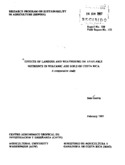Effects of landuse and weathering on available nutrients in volcanic ash soils of Costa Rica: a comparative study

Voir/
Date
1997Auteur
Gerrits, S.
Autor Corporativo
CATIE - Centro Agronómico Tropical de Investigación y Enseñanza
Type
Reporte
Metadata
Afficher la notice complèteDescription
Figuras, tablas, 76 ref. También como: Field Report - CATIE. Research Program on Sustainability in Agriculture; no. 108
Résumé
In the present study two soiltypes, a highly depleted, old soil and a young, fertile soil are compared under three landuse types. The focus of the study is soil moisture and its chemical composition. As a reference, soil sample analyses and mineralogical data are used. Due to a higher data resolution of the young soil sampling period, the young soil data are treated more extensively. In the weathering of the young soil under forest, NO3 and other organic acids were found to play a major role, even though average pH values were still high (about 5). Rain events triggered biomass decomposition to high levels within a day, reflecting the high activity of soil organisms. The conversion of forest to grassland on young soil was found to enhance the base saturation of the soil and lower the Ca/Mg ratio on the exchange complex and in soil moisture, indicating that a main after effect of logging on these soils is enhanced weathering. The main proton donor for this enhanced weathering (CO2) is thought to come from the decay of refractory forest remains and humic material in the soil. The conversion of grassland to plantation led to a lowered base saturation accompanied with extreme concentrations of nutrients in the soil moisture, reflection the ineffectiveness of used fertilisation techniques. In the old soil under forest, nutrient losses were, as expected, much lower than in the young soil. Seaspray was found to have a large influence on the old soil forest nutrient regime. The conversion to grassland on old soil resulted in a lowered base saturation, because the main nutrient holding compartment, the vegetation, (and its seaspray scavenging ability) was removed. Conversion to plantation led to a situation similar to that of the young soil plantation, along with a pronounced dryness.
Keywords
Delegation
Sede Central
Éditeur
CATIE, Turrialba (Costa Rica) | Ministerio de Agricultura y Ganadería, San José (Costa Rica) | Agricultural University of Wageningen, Wageningen (Países Bajos)
Collections
- Publicaciones y documentos [4428]

